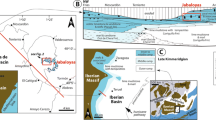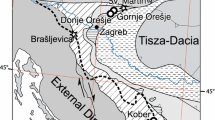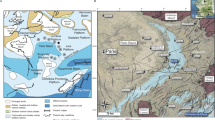Summary
The “Calcare di Mendicino” is a mixed carbonatesiliciclastic informal unit of Miocene (Late Tortonian-Early Messinian age), that crops out extensively in the northwestern part of the Calabria. In the Scannelle quarry near Belsito (Cosenza), four stratigraphic sections were studied to define the sedimentological and paleoecological setting. The carbonate body records the development of a deep-water coral bank characterized by a low-diverse community of azooxanthellate scleractinian (Oculina andDendrophyllia) and stylasterine hydrozoans colonies. Two main stages of bioconstruction development can be distinguished: a thicket and a bank stage. Among the biostromal dwellers the more common are bryozoans, echinoids, benthic foraminifers, gastropods, and bivalves. A higher content of planktonic foraminifers occur in the thicket stage. The coral bank flourished within the aphotic zone, with deep currents loaded with nutrients and siliciclastic sediments.
The upper part of the “Calcare di Mendicino” carbonate body has been affected by a pervasive dolomitization destroying almost completely the sedimentary structures and the biofacies. The lower part, the main object of this paper, preserves the microfacies but it experienced a widespread recrystallization obliterating the primary geochemical characteristics. The diagenetic history, partly hidden, reveals three main stages: primary marine with isopachous fibrous cements, deep burial with cavities infilled by sparry calcite, and meteoric-phreatic with dog-tooth cements.
Similar content being viewed by others
References
Bailey, R. H. and Tedesco, S. A. (1986): Paleoecology of a Pliocene coral thicket from North Carolina: an example of temporal change in community, structure and function.—J. Paleont.,60/6, 1159–1176, Tulsa
Bernecker, M. and Weidlich, O. (1990): The Danian (Paleocene) Coral Limestone of Fakse, Denmark: A Model for Ancient Aphotic, Azooxanthellate Coral Mounds.—Facies22, 103–138, Erlangen
Cairns, S. D. and Stanley, G. D. (1982): Ahermatypic coral banks: living and fossil counterparts.—Proc. Fourth Intern. Coral Reef Symp., Manila, 1981,1, 611–618, Quezon City
Coates, A. G. and Kauffman, E. G. (1973): Stratigraphy, paleontology and paleonvironment of a Cretaceous coral thicket, Lamy, New Mexico.—J. Paleont.,47/5, 953–968, Tulsa
Colella, A. (1995): Sedimentation, deformational events and eustacy in the perithyrrenian Amantea Basin: preliminary synthesis.— Giorn. Geol.,57/1–2, 179–193, Bologna
Di Nocera, S., Ortolani, F., Russo, B. and Torre, M. (1974): Successioni sedimentarie e limite Miocene-Pliocene nella Calabria settentrionale.—Boll. Soc. Geol. Ital.,93/3, 575–607, Roma
Di Nocera, S., Ortolani, F., Russo, B. and Torre, M. (1979): Caratteristiche stratigrafiche e paleoambientali dei depositi altomiocenici nella zona di Falconara Albanese (Catena Costiera Calabra).—Boll. Soc. Natural. Napoli,83, 1–29, Napoli
Esteban, M. (1996): An overview of Miocene reefs from Mediterranean reas: general trends and facies models.—In: Franseen, E. K., Esteban, M., Ward, W. C. and Rouchy J. M. (eds.): Models for carbonate stratigraphy from Miocene reef complexes of Mediterranean regions.—SEPM Spec. Publ.,5, 3–53, Tulsa
Floris, S. (1972): Scleractinian corals from the Upper Cretaceous and Lower Tertiary of Nugssuaq, West Greenland.—Medd. Grönland,196/1, 1–132, Copenhagen
Floris, S. (1980): The coral banks of the Danian of Denmark.—Acta Palaeont. Polonica,25/3–4, 531–540, Warszawa
Frederiksen, R., Jensen, A. and Westerberg, H. (1992): The distribution of the scleractinian coralLophelia pertusa around the Faroe Islands and the relation to internal tidal mixing.—Sarsia,77, 157–171, Bergen
Freiwald, A. and Wilson, J. B. (1998): Taphonomy of modern, deep, cold-temperate water coral reefs. Hist. Biol.,13, 37–52, Amsterdam
Fricke, H. W. and Hottinger, L. (1983): Coral bioherms below the euphotic zone in the Red Sea.—Mar. Ecol. Prog. Ser.,11, 113–117.
Hogg, N. G. (1973): On the stratified Taylor column.—J. Fluid Mech.,58, 517–537, Cambridge
Kenyon, N. H. (1986): Evidence from bedforms for a strong poleward current along the upper continental slope of northwest Europe. —Mar. Geol.,72, 187–198, Amsterdam
Morrone, A. (1991): Sedimentological and stratigraphical study of Miocene deposits of the Calabrian Coast Range, in the area between Falconara Albanese and Cosenza.—Giorn. Geol.,53/2, 93–113, Bologna
Morrone, A., Sonnino, G., Dieci, G. and Sarti, M. (1996): I terreni neogenici della Calabria settentrionale. Sedimentologia e stratigrafia.—Ann. Univ. Ferrara, Sci. Terra,7/1, 1–21, Ferrara
Mullins, H. T., Newton, C. R., Heath, K. and VanBuren, H. M. (1981): Modern deep-water coral mounds north of the Little Bahama Bank: criteria for recognition of deep-water coral bioherms in the rock record.—J. Sedim. Petrol.,51/3, 999–1013, Tulsa
Ortolani, F., Torre, M. and Di Nocera, S. (1979): I depositi altomiocenici del bacino di Amantea (Catena Costiera Calabra).— Boll. Soc. Geol. Ital.,98, 559–587, Roma
Pedley, M. (1996): Miocene reef distributions and their associations in the central Mediterranean regions: an overview.—In: Franseen, E. K., Esteban, M., Ward, W. C. and Rouchy J. M. (eds.): Models for carbonate stratigraphy from Miocene reef complexes of Mediterranean regions.—SEPM Spec. Publ.,5, 73–87, Tulsa
Perri, E. (1999): Tettonica post-tortoniana del settore nordoccidentale dell'Arco Calabro.—St. Geol. Camerti,14 (1996–1997), 155–175, Camerino.
Perrone, V., Torre, M. and Zuppetta, A. (1973): Il Miocene della Catena Costiera Calabra. Primo contributo: zona di Diamante-Bonifati-Sant' Agata d'Esaro (Cosenza).—Riv. Ital. Paleont. Strat.,79, 157–205, Milano
Reed, J. K. (2000): Comparison of deep-waterOculina andLophelia banks off southeastern USA.—First Intern. Symp. deep sea corals, Halifax, July 30—August 2, 2000 (abstract)
Reiss, Z. and Hottinger, L. (1984): The Gulf of Aqaba. Ecological Micropaleontology.—354 p., Berlin (Springer)
Romeo, M. and Tortorici, L. (1980): Stratigrafia dei depositi miocenici della Catena Costiera Calabra meridionale e della media valle del fiume Crati (Calabria).—Boll. Soc. Geol. Ital.,99, 303–318, Roma
Schuhmacher, H. and Zibrowius, H. (1985): What is hermatypic? —Coral reefs,4, 1–9, Berlin, Heidelberg (Springer)
Squires, D. F. (1964): Fossil coral thickets in Wairarapa, New Zealand.—J. Paleont.,38/5, 904–915, Tulsa
Stanley, G. D. (1979): Paleoecology, structure, and distribution of Triassic coral buildups in western North America.—Univ. Kansas Paleontological Contributions,65, 1–68.
Stanley, G. D. (1981): Early history of scleractinian corals and its geological consequences.—Geology,9, 507–511, Boulder
Stanley, G. D. and Cairns, S. D. (1988): Constructional azooxanthellate coral communities: an overview with implications for the fossil record.—Palaios,3, 233–242, Tulsa
Teichert, C. (1958): Cold and deep-water coral banks.—Amer. Ass. Petrol. Geol. Bull.,42/5, 1064–1082, Tulsa
Vella, P. (1964): Foraminifera and other fossils from late Tertiary deep-water coral thickets, Wairarapa, New Zealand.—J. Paleont.,38/5, 916–928, Tulsa
Wells, J. W. (1933): Corals of the Cretaceous of the Atlantic and Gulf coastal plains and western interior of the United States. —Bull. American Paleontology,18, 85–288.
Zankl, H. (1971): Upper Triassic carbonate facies in the northern Limestone Alps. In: Sedimentology of Parts of Central Europe: Guidebook: Heidelberg, Eighth Sedimentological Congress, 147–185.
Zibrowius, H. and Cairns, S. D. (1992): Revision of the northeast Atlantic and Mediterranean Stylasteridae (Cnidaria: Hydrozoa). —Mem. Mus. Natn. Hist. Nat. (A),153, 1–136, Paris
Author information
Authors and Affiliations
Rights and permissions
About this article
Cite this article
Mastandrea, A., Muto, F., Neri, C. et al. Deep-water coral banks: an example from the “Calcare di Mendicino” (Upper Miocene, Northern Calabria, Italy). Facies 47, 27–42 (2002). https://doi.org/10.1007/BF02667704
Received:
Revised:
Issue Date:
DOI: https://doi.org/10.1007/BF02667704




